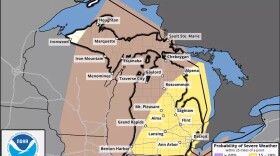While sticks and debris from downed trees covers much of the forest floor in northern Michigan, workers are trying to bring order to the chaos.
Piles of sticks line the dirt road, while cleanly-cut tree limbs are picked up by machines and placed on trucks. Nearby a large track harvester is clearing a field of damaged trees.
“All the ones that are still standing, most of the tops are on the ground, so we'll cut the main tree down, delimb that, and cut that to length and then grab the top,” said operator Billy Bogner. “It's a little challenging because everything's broke.”
A massive ice storm hit northern Michigan in late March, knocking down limbs and trees across an estimated 3 million acres. The acres of fallen trees and brush have created concern over invasive species and the looming threat of wildfires. Months later, the timber industry and environmental officials are in a race to salvage what they can and avoid those threats.
Bogner, who works for Precision Forestry, a company that’s working to help clean up after the historic ice storm, said his work days usually last 10-12 hours. Bogner indicated that the size of the job wasn’t out of the ordinary, but there was still a good amount of manpower needed.
“We have seven two-man crews,” Bogner said. “You got the harvester operator and a forwarder operator forwarder operators comes through and picks up all the wood and gets it on the trucks.”
While Gov. Gretchen Whitmer requested federal emergency relief in April, the state is still waiting.

Salvage logging
Tricia St. Pierre drives through the state forestland in Gaylord, surveying the damage on a recent summer day. The forester with the Michigan Department of Natural Resources said the March ice storm tore down trees and left brush on the forest floor.
“Just over 900,000 acres, which is almost one-fourth of the state forest that we manage,” she said.
The storm blocked roads and left more than 145,000 people without power, heat, fuel and internet, some for as long as two weeks. The area, which includes rural communities and cities, turned to warming centers as residents braced temperatures in the 30s. More than 4,600 electric poles were replaced by two major energy co-ops in the region in the three months since the storm.
“We had people on the ground with chainsaws as soon as there was a report of a tree blocking the road, it was pretty incredible,” St. Pierre said of the state response. “It was really empowering to see the way that people came together and, as a DNR, the response to help local communities and help each other.”
Now, much of the focus has turned to the state’s forests, which contributed over $26 billion to the state’s economy in 2022 and more than 40,000 jobs.
Even damaged trees have some value if loggers can get to them fast enough, said Michael Jacobson, a professor of Forest Resources at Penn State.
“The idea is that there's probably still some value in the trees, even if they've broken off at the tops,” he said. “Some of the wood could be used for low value uses like biofuels fuel, wood, other new products that are coming in that could be used from wood.”
While the timber market in the Midwest has remained stable, even after the storm, Jacobson said clearing debris and broken trees is also important for forest health.
But, he said, it takes expertise.
“Generally with salvage logging, it doesn't mean that you're taking out everything,” he said.”If you do it well with a good forester, you'll be able to leave important trees that are important for environment or wildlife and also protect the soils.”

Other forest threats
The ice storm created conditions that leave the forests vulnerable to other threats; including wildfires and invasive species.
All of the dead limbs and trees provide wildfire fuel, according to Kerry Heckman, a spokesperson with the Michigan Department of Natural Resources.
“There's a lot of trees that are bent over but still connected, and that creates what we call ladder fuels,” she said, “which basically allows fire to go from the ground to climb the trees and turn into a crown fire.”
Heckman said clearing roads and cleaning high-risk areas prone to fires are a top priority.
Officials also are working to clean up dead wood before invasive species get a foothold. In Michigan that includes Bark Beetles, which can spread oak wilt and other diseases that kill trees.
Bark beetles burrow into trees and disrupt the trees’ internal transportation of nutrients, killing the tree. Simeon Wright, a forest health pathologist with the state’s DNR said the cleaning process is needed to protect the overall forest.
“There's broken material on the ground that hasn't dried out yet. Those bark beetles can successfully reproduce in those materials and start to build higher populations that can overcome the defenses of healthier trees.”
Back in Tricia St. Pierre’s state vehicle, she said there’s a lot of work still left to do. Michigan’s parks were able to open before the summer vacation season, but they still have thousands of acres to clear.
Even though dealing with storms is a natural part of a forest’s cycle, St. Pierre said it’s hard to know what the long-term consequences of a weather event of this size will be for Michigan’s forests.
“Forest succession kind of depends on those disturbances,” she said, “but something this scale being from an ice storm, that's unprecedented for us.”
This story was produced in partnership with Harvest Public Media, a collaboration of public media newsrooms in the Midwest. It reports on food systems, agriculture and rural issues.




